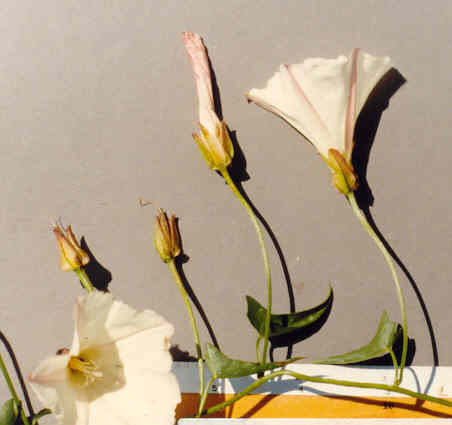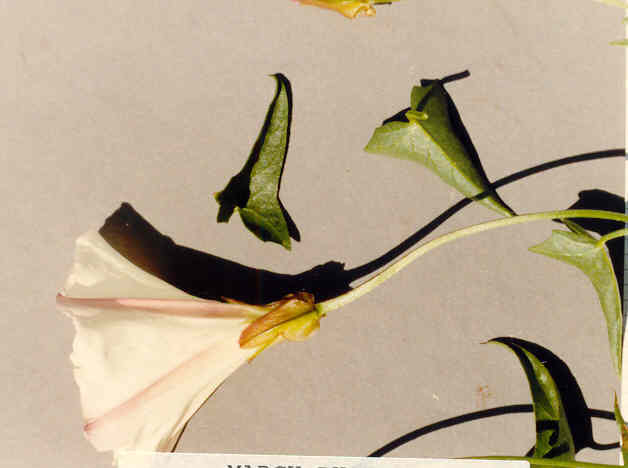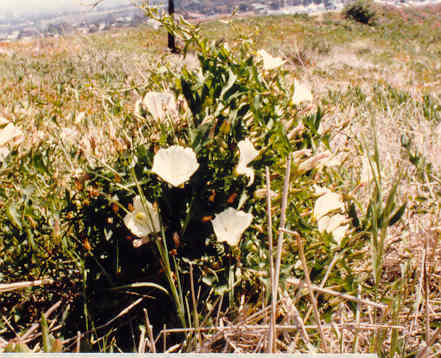
Calystegia macrostegia ssp. cyclostegia
(House) Brummitt
Convolvulaceae (Morning-Glory Family) Native
 |
Calystegia macrostegia ssp. cyclostegia(House) Brummitt
Convolvulaceae (Morning-Glory Family) Native
Island Morning Glory |
March Photo
Plant Characteristics:
Perennial, stems wiry, trailing or twining, 1-4 m. long; lvs. rather
fleshy, deltoid-hastate, broader than long to slightly less broad than long,
2-4.5 cm. long, the basal lobes usually toothed or angled; petioles much shorter
than blades; bracts near to and like the calyx, mostly subcordate at base,
membranous and purplish, 10-15 mm. long, +/-pointed; corolla 2.5-4.5 cm. long;
seeds ca. 3 mm. long reticulate-ridged.
Habitat:
Dry slopes up to 1500 ft. elev.; Coastal Sage Scrub, Chaparral; mostly
near the coast; n. Los Angeles Co. to Monterey Co., Catalina Id.
March-Aug.
Name:
Greek, kalux, husk and stegos, a covering. (Munz,
Flora So. Calif. 371).
Greek, makros, large and Greek,
stegos, a covering.
(Jaeger 147,246). This seems
to say the same thing as the genus name? (my comment).
Greek, kyklos, a circle and stegos,
a covering. (Jaeger 73, 147). The
ssp. name probably refers to the shape of the calyx which encircles the flower
tube. (my comment). John Johnson suggests that macrostegia
means that this particular species has the bract husk covering considerably
enlarged and that cyclostegia means
that in this subspecies the husk covering encircles the calyx more closely than
in the typical form.
General:
Uncommon in the study area, having been found only on the Castaway's
bluffs, along the bike and horse path in Santa Ana Heights and in the canyon
northerly of the Newporter Inn. Photographed on the Castaway's bluffs.
There was only one plant at each location
(my comments).
A tincture of the whole plant was once considered beneficial for
medicinal purposes. (Dale 101).
The genus resembles Convolvulus,
but with pollen sphaeroidal, stigma oblong, +/- cylindrical with blunt apices,
the stigmatic area and style distinct. Caps.
1-locular with an incomplete septum. A fairly large genus of which the ssp. have previously
largely been referred to Convolvulus.
(Munz, Flora So. Calif. 371.
Intergrades with ssp. macrostegia, ssp. intermedia, and C. purpurata ssp. purpurata. (Hickman,
Ed. 518). Delfina
Cuero, a Kumeyaay or Southern Diegueno Indian made the following comment about C.
macrostegia ssp. arida in her autobiography:
"We used it as a medicine; boiled the whole plant and bathed sores
in the liquid." (Shipek 88).
Text Ref:
Abrams Vol. III 383; Hickman, Ed. 518; Munz, Flora
So. Calif. 374; Roberts 20.
Photo Ref:
March-April 87 # 5,6,7.
Identity: by R. De Ruff,
confirmed by F. Roberts.
First Found: March 1987.
Computer Ref: Plant Data 310.
Have plant specimen.
Last edit 3/4/05.
 |
 |
March Photo March Photo